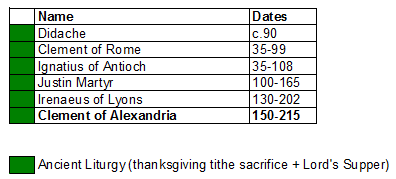The original liturgy:

The Roman liturgy:

Clement of Alexandria

To respond to this, we need only share a bigger quote:
But you are not inclined to understand it thus, but perchance more generally. Hear it also in the following way. The flesh figuratively represents to us the Holy Spirit; for the flesh was created by Him. The blood points out to us the Word, for as rich blood the Word has been infused into life; and the union of both is the Lord, the food of the babes— the Lord who is Spirit and Word. The food— that is, the Lord Jesus— that is, the Word of God, the Spirit made flesh, the heavenly flesh sanctified.
Citation: Clement of Alexandria, “The Instructor, Book 1”
Clement believed that the flesh and blood of Christ were metaphors for the Holy Spirit and the Word of God that leads to eternal life (see Jesus’ reference to Isaiah 55 in John 6). Who can read the following, and conclude that Clement wasn’t speaking of the elements figuratively?
Thus in many ways the Word is figuratively described, as meat, and flesh, and food, and bread, and blood, and milk. The Lord is all these, to give enjoyment to us who have believed on Him. Let no one then think it strange, when we say that the Lord’s blood is figuratively represented as milk. For is it not figuratively represented as wine? Who washes, it is said, His garment in wine, His robe in the blood of the grape. Genesis 49:11 In His own Spirit He says He will deck the body of the Word; as certainly by His own Spirit He will nourish those who hunger for the Word.
Citation: Clement of Alexandria, “The Paedagogus, Book I“
Clement also said…
Citation: Clement of Alexandria, “The Paedagogus, Book I“, Chapter 6
…using figurative language. Clement no more believed that the bread and wine were the literal blood and body of Christ than he believed that the Christ’s blood and milk were literally his passion and teaching. Such is absurdity.
Clement also said…
Citation: Clement of Alexandria, “The Instructor, Book II“
…clearly highlighting the symbolic language. There is no indication in Clements figurative language that he had any conception of the literal body and blood of Christ in bread and wine.


Pingback: The Eucharist, Part 10: Origen of Alexandria